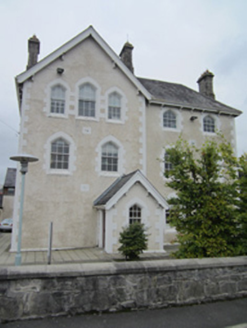Survey Data
Reg No
41303037
Rating
Regional
Categories of Special Interest
Architectural, Social
Previous Name
Monaghan Constabulary Barrack
Original Use
RIC barracks
Historical Use
Garda station/constabulary barracks
In Use As
Office
Date
1870 - 1880
Coordinates
267310, 334131
Date Recorded
04/10/2011
Date Updated
--/--/--
Description
Detached irregular-plan three-storey former police barracks, built 1875, having four-bay front elevation, western two bays projecting and gable-fronted, with gabled porch to front, and other elevations being essentially three-bay. Now in use as council offices. Pitched natural slate roof to north section, hipped front block, with grey clay ware ridge tiles, dressed sandstone shouldered chimneystacks that project from top of wall faces, with sloped copings and terracotta pots, projecting rafters with timber brackets to eaves, timber bargeboards to gables with moulded brackets, cast-iron profile guttering and rainwater goods to fascias supported on carved timber brackets. Roughcast rendered walls with painted block-and-start quoins to margins, and painted projecting sandstone plinth with sloped coping. Painted ashlar sandstone block-and-start surrounds with chamfered margins to all openings. Tudor-arch window openings with six-over-six pane horned timber sliding sash windows, and square-headed door opening with timber panelled doors. Set within own grounds with tarmacadam-surfaced car park surrounding. Low rubble boundary wall to west. Converted two-storey outbuilding to rear having pitched slate roof and random rubble walls.
Appraisal
This former police station is a fine example of Victorian public architecture. It has an impressive scale and simple aesthetics, and displays well maintained intrinsic architectural fabric including timber sash windows and its slate roof. The building's significance is social as well as architectural. The evident high-quality stone masonry in window surrounds and chimneys demonstrate the intended longevity of the building and its continued use is testament to this.

